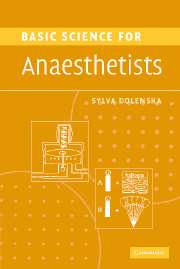Book contents
- Frontmatter
- Contents
- List of abbreviations and symbols
- List of figure captions
- Forewords
- Preface
- Preface to the second edition
- Part 1 Physics, mathematics, statistics, anaesthetic apparatus
- 1 Gas compression, relationship of volume, pressure and temperature
- 2 Real gas compression
- 3 Flow and resistance
- 4 Heat, vaporization and humidification
- 5 Simple mechanics 1: mass, force, pressure
- 6 Simple mechanics 2: work and power
- 7 Mathematical concepts
- 8 Exponentials 1: the curves
- 9 Exponentials 2: properties of exponential decay curve
- 10 Descriptive statistics
- 11 Presentation of data
- 12 Receiver operating characteristic curve
- 13 Gas supply and pressure
- 14 The circle system
- 15 The Mapleson A (Magill) breathing system
- 16 T-pieces
- 17 Lung filling with automatic lung ventilators
- Part 2 Clinical measurement
- Part 3a Physiology: the cardiovascular system
- Part 3b Physiology: the respiratory system
- Part 4 Pharmacology
- Further Reading
- Index
2 - Real gas compression
from Part 1 - Physics, mathematics, statistics, anaesthetic apparatus
Published online by Cambridge University Press: 13 August 2009
- Frontmatter
- Contents
- List of abbreviations and symbols
- List of figure captions
- Forewords
- Preface
- Preface to the second edition
- Part 1 Physics, mathematics, statistics, anaesthetic apparatus
- 1 Gas compression, relationship of volume, pressure and temperature
- 2 Real gas compression
- 3 Flow and resistance
- 4 Heat, vaporization and humidification
- 5 Simple mechanics 1: mass, force, pressure
- 6 Simple mechanics 2: work and power
- 7 Mathematical concepts
- 8 Exponentials 1: the curves
- 9 Exponentials 2: properties of exponential decay curve
- 10 Descriptive statistics
- 11 Presentation of data
- 12 Receiver operating characteristic curve
- 13 Gas supply and pressure
- 14 The circle system
- 15 The Mapleson A (Magill) breathing system
- 16 T-pieces
- 17 Lung filling with automatic lung ventilators
- Part 2 Clinical measurement
- Part 3a Physiology: the cardiovascular system
- Part 3b Physiology: the respiratory system
- Part 4 Pharmacology
- Further Reading
- Index
Summary
Forces of adhesion in the gas lessen the impact on the container. The result is that the pressure measured is less than that predicted by the universal gas equation. The effect is magnified in a smaller volume.
Also, the molecules are not negligible in size; their total volume lessens the volume of the container, decreasing the distance of travel; a correction for the volume of the molecules (Vo) has to be applied.
When gas is compressed at a sufficiently low temperature, the forces of adhesion eventually cause its liquefaction (i.e. the forces of attraction overcome the random thermal motion).
Isothermic compression – decompression
Figure 3 shows slow compression of nitrous oxide under various temperature conditions. Because compression is slow, there is sufficient time for temperature equilibration with the surroundings. This pressure–volume change is called isothermic.
The top isotherm for 50 ℃ behaves as an ideal gas isotherm. At 36.5 ℃ the isotherm just touches the lightly shaded area in the graph, which represents the gas and liquid phase. This temperature is the critical temperature of nitrous oxide, above which the gas cannot be liquefied at any pressure. At lower temperatures, here 20 ℃, the gas can be liquefied. If compression is slow to allow temperature to remain constant, the pressure in the container remains constant until all gas is liquefied: the decrease in volume of the container is matched by a decrease in volume of the gaseous phase (which is now called vapour) as it is being liquefied.
- Type
- Chapter
- Information
- Basic Science for Anaesthetists , pp. 4 - 7Publisher: Cambridge University PressPrint publication year: 2006



